How to Identify and Target Long-tail Keywords for SEO


Hand off the toughest tasks in SEO, PPC, and content without compromising quality
Explore ServicesTired of slugging it out for broad keywords that take forever to crack?
Long-tail keywords are your way out: specific, winnable, and packed with intent.
Get ready to rank smarter 👇
What Are Long-tail Keywords?
Long-tail keywords are specific, multi-word phrases, often three words or more, that zero in on what users are really after. Compared to short, broad terms, they pull lower search volume but face less competition, making them easier to rank for.
Benefits of Long-tail Keywords for SEO
Long-tail keywords dodge the brutal competition of broad terms like “shoes” or “protein powder,” where big brands with deep pockets dominate. Instead, phrases like “best lightweight hiking boots 2025” have fewer players, letting you climb SERPs quicker, often in weeks, not years.
Long-tail keywords also signal higher intent.
You see, someone typing “vegan protein” might just be browsing for nutritional insights, but “best plant-based protein powder under $30” signals they’re much, much closer to making a purchase. Long-tail keywords often attract fewer organic traffic, sure, but the visitors they do attract are ready to act, not tire kick.
Long-tails also match what users want, boosting relevance and engagement over vague, scattershot terms. Plus, they’re built for today’s Google ranking preferences, which prize precision and user value over broad, “optimized for search” content.
How to Find Long-tail Keywords That Work
That’s the what and the why out of the way. Now, let’s get into the crux of this thing: the how.
1. Brainstorming Seed Keywords
Seed keywords are the foundation of your long-tail hunt because they anchor everything to your site’s niche. Think of them as the core terms that define what you’re about, broad enough to start with but ripe for narrowing down later.
How:
- Grab a pen or open your note-taking app and list 5–10 core terms tied to your niche.
- Think along the lines of products, problems, or people. For a site that specializes in outdoor camping and hiking equipment, that might look like: “waterproof tents,” “blister prevention,” or “beginner campers.”
- Hit a wall? Fire up ChatGPT or Gemini and use a prompt like “Brainstorm 10 seed keywords for a website that specializes in [whatever the site’s niche is].”


- Skim your site’s pages or client brief to spot recurring themes or phrases you’ve overlooked.
- Keep it simple. No long-tails yet, just broad terms to build from.
2. Expanding with Keyword Tools
Time to turn those seed keywords into long-tails. A keyword tool like Ahrefs makes this process super easy, not to mention they pull real data on what people search, how often, and how tough the competition is, saving you from blind stabs in the dark.
How:
- Open Ahrefs Keywords Explorer, enter your seed keywords, and hit Search.


- From the left-hand side navigation menu, hit Matching terms to pull up all the keywords that are relevant to your seed keywords. Then, filter for long-tails by setting word count to 3+.

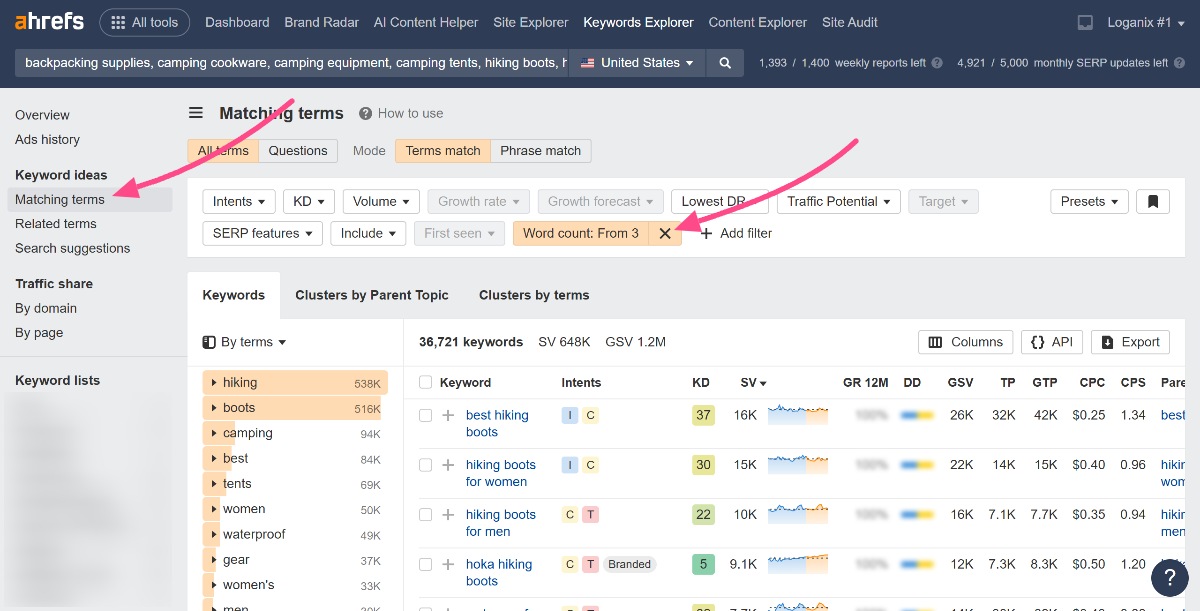
- Look at the Phrase Match or Questions tabs for more intent-driven ideas.

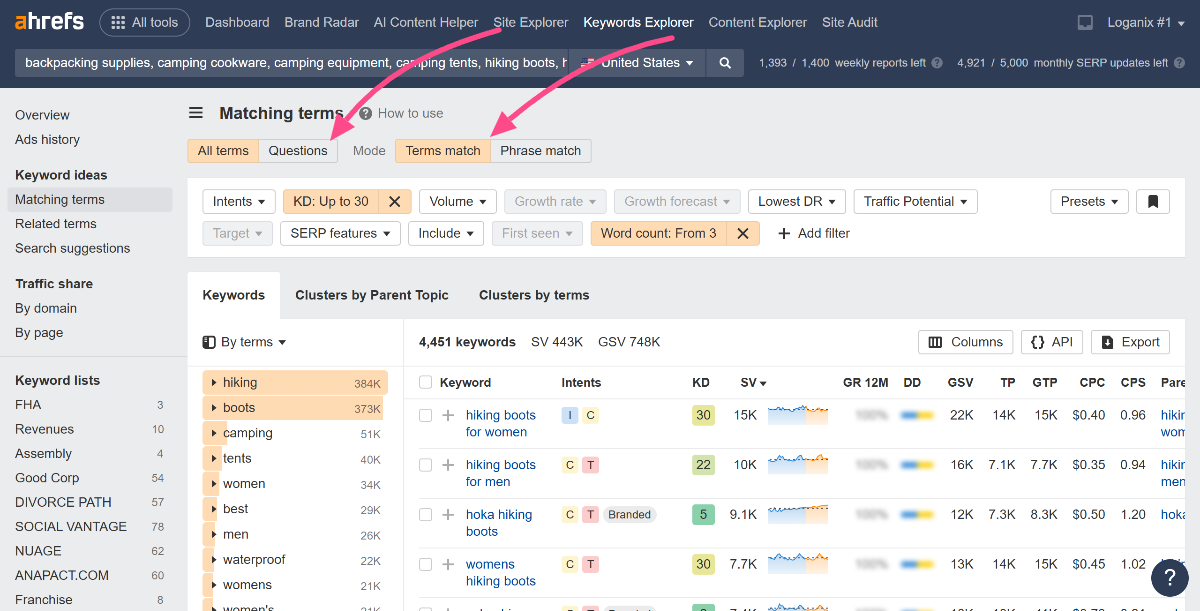
3. Analyzing Search Volume and Difficulty
Search volume (SV) tells you how many people search for a specific keyword monthly, so you’re not chasing dead ends with zero traffic potential. Keyword difficulty (KD) shows how tough the competition is, keeping you from wasting time on keywords dominated by high-authority sites you can’t touch (yet 😉).
Together, both metrics filter out the noise: low-volume, low-KD keywords can deliver quick wins.
How:
- Continuing to use the keyword list we generated in step two, add a KD filter that eliminates any words that have a keyword difficulty of 30 or more.


- Then, add another filter that eliminates low search volume terms.

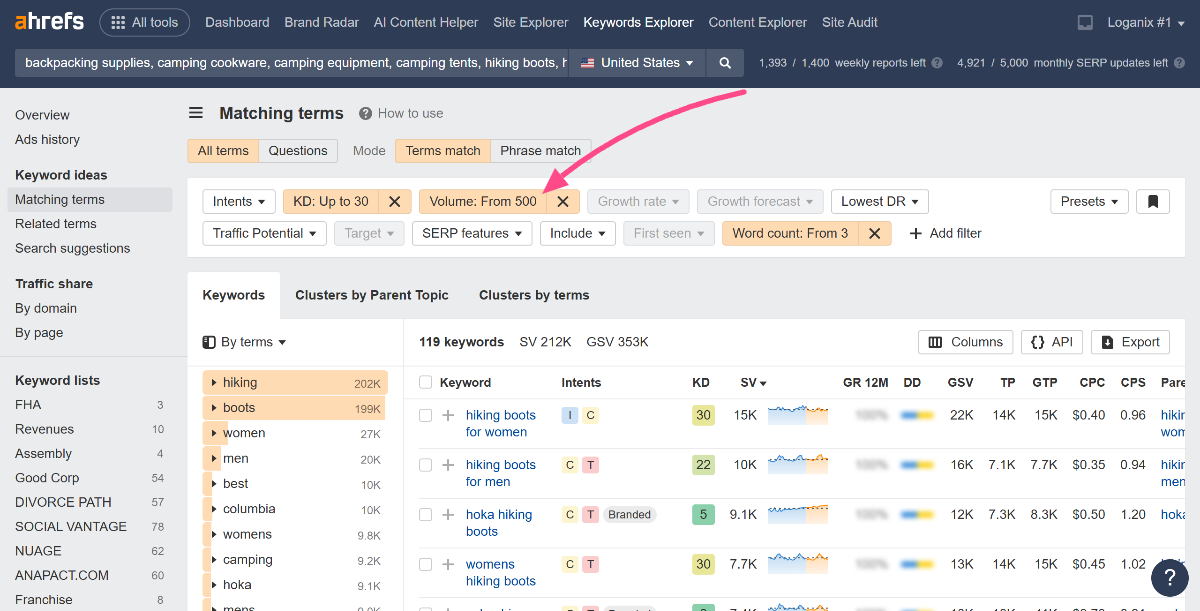
4. Assessing Search Intent
Search intent is the make-or-break factor that keeps your content from missing the mark with users. Get it wrong, and you’re crafting pieces that don’t line up with what people want, whether they’re hunting for info, a specific site, or a product to buy.
That mismatch kills relevance, tanks rankings, and wastes your time on traffic that bounces instead of converts. Matching search intent does the exact opposite.
How:
- Continuing from where we left off, look for the Intents column next to each keyword.

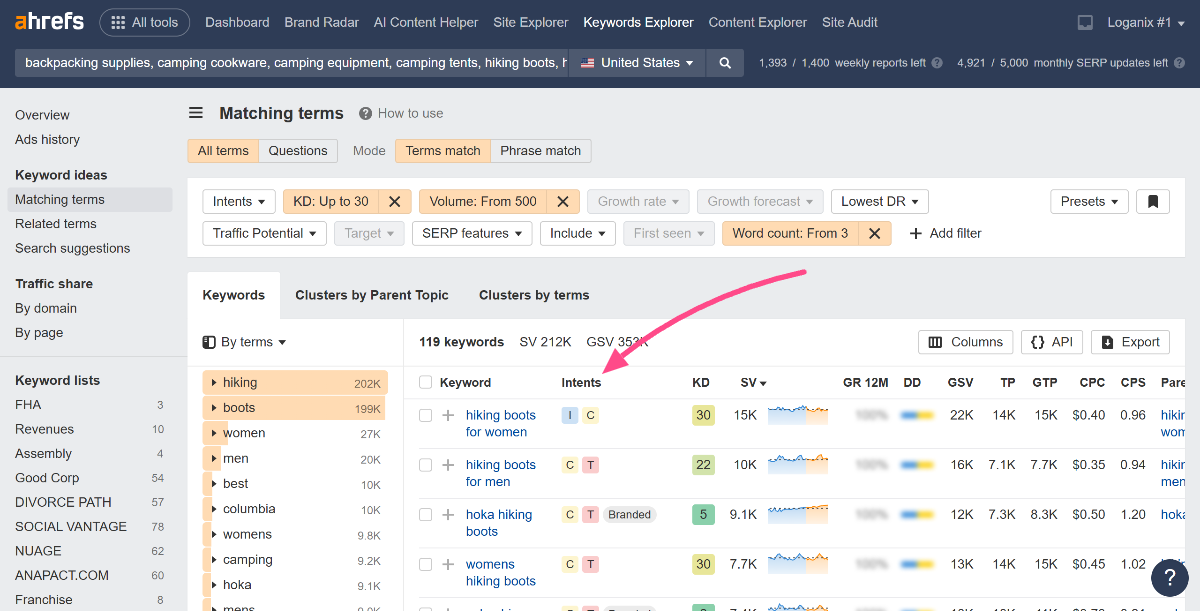
- Check the tags: N (navigational), I (informational), C (commercial), T (transactional).
- Peek at top SERPs for each keyword to confirm intent aligns with ranking content.
- Sort or filter by intent type to prioritize based on your strategy.
5. Grouping by Theme
Clustering by theme sets up posts or pages that hit multiple angles at once, boosting topical depth that Google craves in 2025. It’ll also make building out pillar pages and topic clusters a cinch.
How:
- Continuing right along from where we left off, peek at the Parent Topic column for a rough starting point on themes.


- Once you’ve got a rough idea, export your long-tail list to a CSV file from the tool’s export option.


- Feed the CSV into ChatGPT with a prompt like “Group these keywords into themes based on similarity.”


- Take ChatGPT’s output, export it to a spreadsheet, and open it up.
- Manually tweak the groupings. Shift or cut anything that looks off since AI won’t nail it perfectly.
Targeting Long-tail Keywords
Keyword list sorted, let’s get creating!
1. Prioritizing Keywords to Target
You’ve got a filtered list now, but chasing every term risks spreading your efforts too thin, leaving you with middling rankings and no real traction. Prioritizing matters because the right long-tails—ones with solid volume, low competition, niche relevance, and tight audience fit—deliver traffic that sticks around and converts.
How:
- Review your filtered Ahrefs list as a baseline.
- Now, score relevance. Does “best hiking boots for beginners” fit your site’s niche and audience over “hiking boots cheap”? Could you target both?
- Check intent tags (N, I, C, T) to match your goal. Informational for blogs, transactional for product pages.
- Take another peek at the SERPs for each term. Can your site compete with current top pages (e.g., DR 20–40, not 70+)?
- Rank your top 5–10 by potential impact—traffic, conversions, or brand fit—and start there. Ahrefs has another metric called TP, or traffic potential. Traffic potential is “the total amount of organic traffic that the #1 ranking page for your target keyword gets from all the keywords it ranks for.” Make use of this metric here.

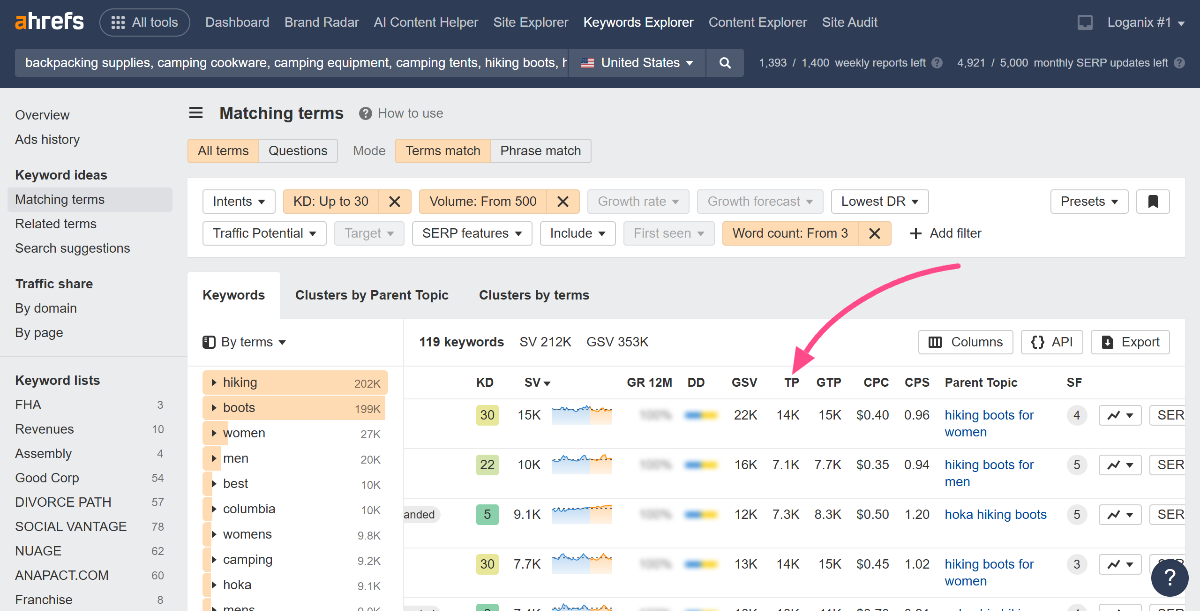
2. Mapping to Your Content Calendar
Strategic scheduling taps into audience habits, seasonal trends, or campaign goals, maximizing every keyword’s punch. A term like “vegan protein reviews 2025” thrives in January’s fitness surge, while “cheap hiking boots” peaks in spring for the outdoor season.
Without this step, you’re just hoping for traction instead of driving it.
How:
- Take your prioritized long-tail list, feed it to ChatGPT, and prompt something like, “Create a 3-month content calendar for the attached keyword list, publishing twice weekly, targeting traffic growth.”


- You can work from the spreadsheet, import it to Google Sheets, or if you’re into it, use a tool like Notion to create a content calendar. Simply search “Content Calendar” in Notion’s template gallery and pick one.


- Plug your keywords into the template, assigning dates based on ChatGPT’s suggestions or seasonal trends.
- Assign writers, set deadlines, and select content types—blogs for informational, product pages for transactional—in Notion to keep it organized.
3. On-Page Optimization Tips
A half-baked on-page setup risks leaving your content buried, no matter how solid your keyword picks are. Nail the title, headers, and meta tags, and you’re crafting a clear path for crawlers and users alike.
How:
- Pack your title, H1, and meta description with your target long-tail and secondary keywords. Keep it natural, of course. Don’t go overboard, risk sounding robotic, and turn off your readers.
- Add internal links to relevant pages, using descriptive anchor text.
- Drop external links to high-authority sites for credibility, like studies or trusted sources of information.
- Write image alt text with your target keyword.
- Run your draft through MarketMuse or Clearscope to weave in LSI keywords.

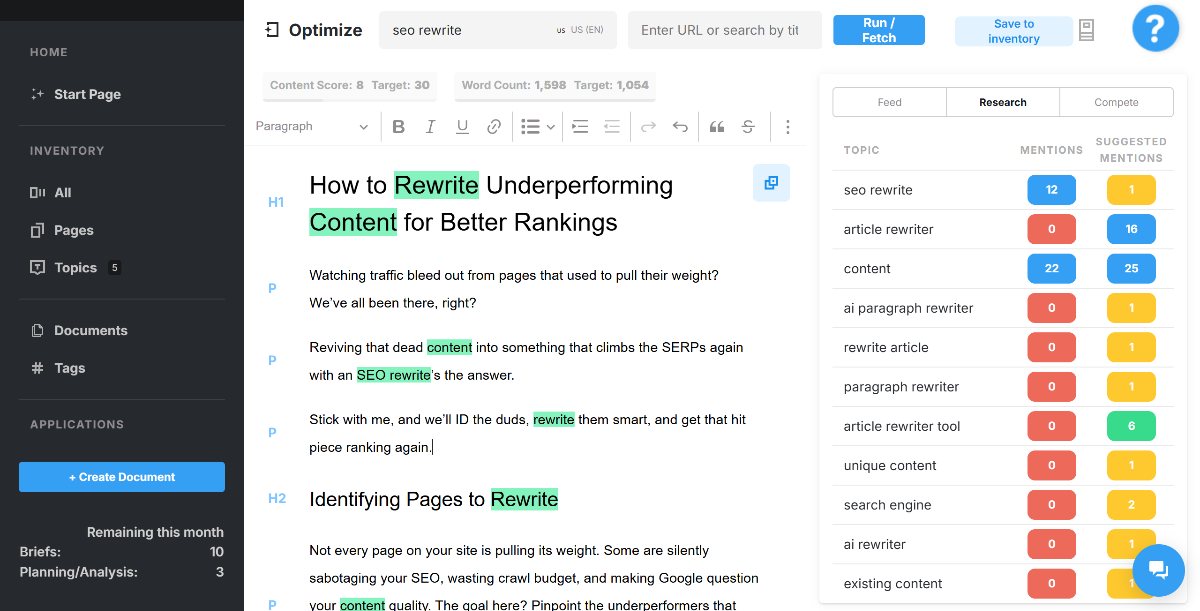
4. Tracking Rankings and Traffic
Tracking rankings and traffic is the last piece of the puzzle, and the only way to prove your long-tail keyword strategy is hitting the mark or flopping hard. Rankings show where you stand on the SERPs, but traffic ties that to real outcomes: clicks, engagement, conversions.
Remember, no data means no insight into what’s working or where to pivot, leaving you stuck with assumptions instead of progress.
How:
- Set up Ahrefs’ Rank Tracker or Semrush’s Position Tracking tool to check rankings across devices and locations, tagging keywords for focus.

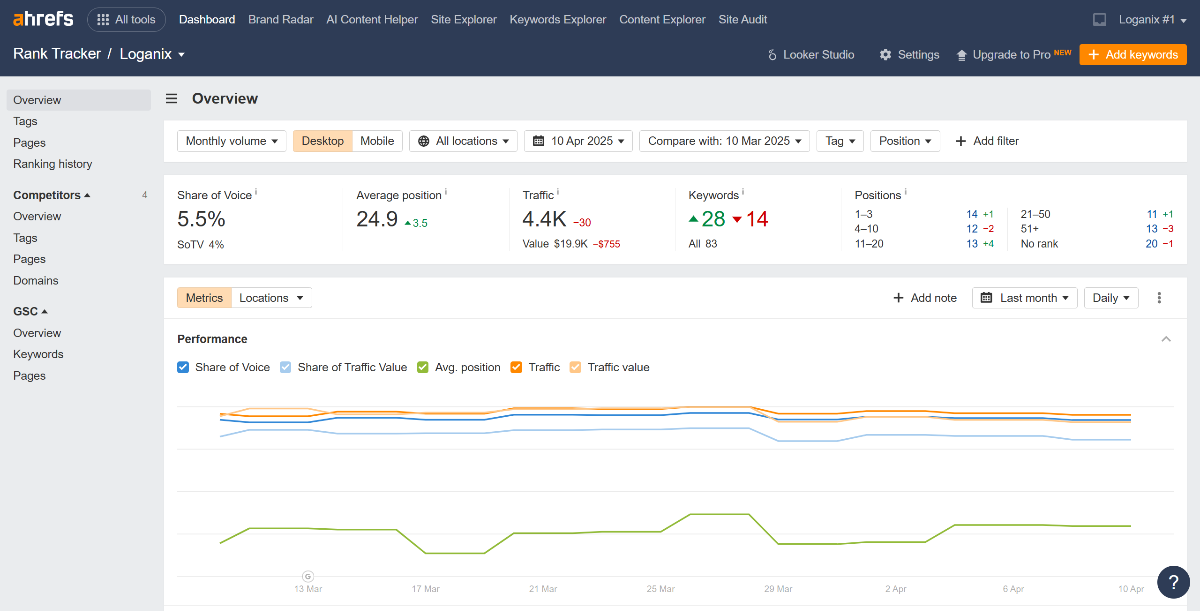
- Use Google Search Console to track organic traffic for your target pages.
- Compare ranking shifts (e.g., #15 to #5) with traffic spikes in GSC over 30–60 days.
- Log key metrics—positions, clicks, impressions—in a spreadsheet to spot trends and adjust.
Conclusion and Next Steps
You’ve got the full playbook now: finding long-tail keywords, targeting them with precision, and tracking the wins that matter.
But let’s be real: digging up seed keywords, sifting through tools, analyzing intent, and mapping it all out can eat up hours you may not have.
That’s where Loganix, that’s us, comes in.
Simply, hand us five seed topics, and our team delivers a tight, action-ready report packed with high-value keywords.
👉 Check out our keyword research service and let’s target those keywords that count. 👈
Hand off the toughest tasks in SEO, PPC, and content without compromising quality
Explore ServicesWritten by Brody Hall on April 29, 2025
Content Marketer and Writer at Loganix. Deeply passionate about creating and curating content that truly resonates with our audience. Always striving to deliver powerful insights that both empower and educate. Flying the Loganix flag high from Down Under on the Sunshine Coast, Australia.
























